Engage NY Eureka Math 1st Grade Module 2 Lesson 11 Answer Key
Eureka Math Grade 1 Module 2 Lesson 11 Sprint Answer Key
A
*Write the missing number.
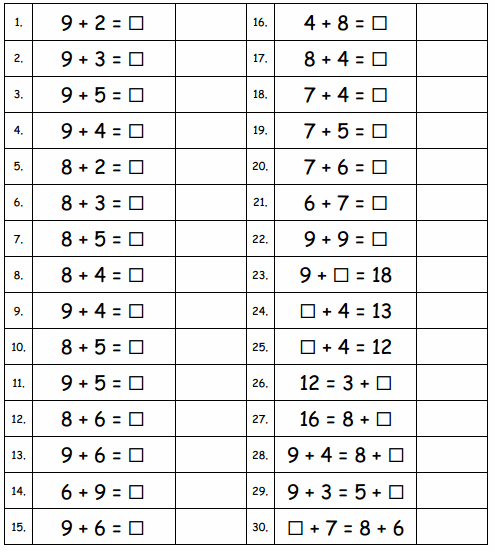
Answer:
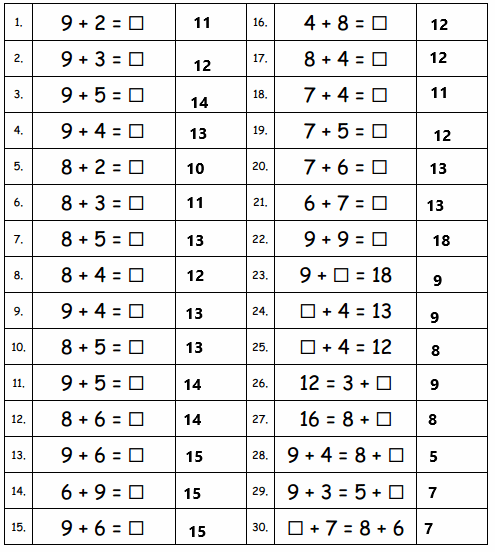
Question 1.
9 + 2 = ☐
Answer:
9 + 2 = 11
Explanation:
An addition sentence is a mathematical expression that shows two or more values added together. ADD nine with two then we got eleven.
Question 2.
9 + 3 = ☐
Answer:
9 + 3 = 12
Explanation:
An addition sentence is a mathematical expression that shows two or more values added together. ADD nine with three then we got twelve.
Question 3.
9 + 5 = ☐
Answer:
9 + 5 = 14
Explanation:
An addition sentence is a mathematical expression that shows two or more values added together. ADD nine with five then we got fourteen.
Question 4.
9 + 4 = ☐
Answer:
9 + 4 = 13
Explanation:
An addition sentence is a mathematical expression that shows two or more values added together. ADD nine with four then we got thirteen.
Question 5.
8 + 2 = ☐
Answer:
8 + 2 = 10
Explanation:
An addition sentence is a mathematical expression that shows two or more values added together. ADD eight with two then we got ten.
Question 6.
8 + 3 = ☐
Answer:
8 + 3 = 11
Explanation:
An addition sentence is a mathematical expression that shows two or more values added together. ADD eight with three then we got eleven.
Question 7.
8 + 5 = ☐
Answer:
8 + 5 = 13
Explanation:
An addition sentence is a mathematical expression that shows two or more values added together. ADD eight with five then we got thirteen.
Question 8.
8 + 4 = ☐
Answer:
8 + 4 = 12
Explanation:
An addition sentence is a mathematical expression that shows two or more values added together. ADD eight with four then we got twelve.
Question 9.
9 + 4 = ☐
Answer:
9 + 4 = 13
Explanation:
An addition sentence is a mathematical expression that shows two or more values added together. ADD nine with four then we got thirteen.
Question 10.
8 + 5 = ☐
Answer:
8 + 5 = 13
Explanation:
An addition sentence is a mathematical expression that shows two or more values added together. ADD eight with five then we got thirteen.
Question 11.
9 + 5 = ☐
Answer:
9 + 5 = 14
Explanation:
An addition sentence is a mathematical expression that shows two or more values added together. ADD nine with five then we got fourteen.
question 12.
8 + 6 = ☐
Answer:
8 + 6 = 14
Explanation:
An addition sentence is a mathematical expression that shows two or more values added together. ADD eight with six then we got fourteen.
Question 13.
9 + 6 = ☐
Answer:
9 + 6 = 15
Explanation:
An addition sentence is a mathematical expression that shows two or more values added together. ADD nine with six then we got fifteen.
Question 14.
6 + 9 = ☐
Answer:
6 + 9 = 15
Explanation:
An addition sentence is a mathematical expression that shows two or more values added together. ADD six with nine then we got fifteen.
Question 15.
9 + 6 = ☐
Answer:
9 + 6 = 15
Explanation:
An addition sentence is a mathematical expression that shows two or more values added together. ADD nine with six then we got sixteen.
Question 16.
4 + 8 = ☐
Answer:
4 + 8 = 12
Explanation:
An addition sentence is a mathematical expression that shows two or more values added together. ADD four with eight then we got twelve.
Question 17.
8 + 4 = ☐
Answer:
8 + 4 = 12
Explanation:
An addition sentence is a mathematical expression that shows two or more values added together. ADD eight with four then we got twelve.
Question 18.
7 + 4 = ☐
Answer:
7 + 4 = 11
Explanation:
An addition sentence is a mathematical expression that shows two or more values added together. ADD seven with four then we got eleven.
Question 19.
7 + 5 = ☐
Answer:
7 + 5 = 12
Explanation:
An addition sentence is a mathematical expression that shows two or more values added together. ADD seven with five then we got twelve.
Question 20.
7 + 6 = ☐
Answer:
7 + 6 = 13
Explanation:
An addition sentence is a mathematical expression that shows two or more values added together. ADD seven with six then we got thirteen.
Question 21.
6 + 7 = ☐
Answer:
6 + 7 = 13
Explanation:
An addition sentence is a mathematical expression that shows two or more values added together. ADD six with seven then we got thirteen.
Question 22.
9 + 9 = ☐
Answer:
9 + 9 = 18
Explanation:
An addition sentence is a mathematical expression that shows two or more values added together. ADD nine with nine then we got eighteen.
Question 23.
9 + ☐ = 18
Answer:
9 + 9 = 18
Explanation:
An addition sentence is a mathematical expression that shows two or more values added together. ADD nine with nine then we got eighteen.
Question 24.
☐ + 4 = 13
Answer:
9 + 4 = 13
Explanation
An addition sentence is a mathematical expression that shows two or more values added together. ADD nine with four then we got thirteen.
Question 25.
☐ + 4 = 12
Answer:
8 + 4 = 12
Explanation:
An addition sentence is a mathematical expression that shows two or more values added together. ADD eight with four we got twelve.
Question 26.
12 = 3 + ☐
Answer:
12= 3 + 9
Explanation:
An addition sentence is a mathematical expression that shows two or more values added together. ADD three with nine then we got twelve.
Question 27.
16 = 8 + ☐
Answer:
16 = 8 + 8
Explanation:
An addition sentence is a mathematical expression that shows two or more values added together. ADD eight with eight then we got sixteen.
Question 28.
9 + 4 = 8 + ☐
Answer:
9 + 4 = 8 + 5
Explanation:
An addition sentence is a mathematical expression that shows two or more values added together. ADD nine with four then we got thirteen. ADD eight with five then we got thirteen. Both are equal number sentences.
Question 29.
9 + 3 = 5 + ☐
Answer:
9 + 3 = 5 + 7
Explanation:
An addition sentence is a mathematical expression that shows two or more values added together. ADD nine with three then we got twelve. ADD five with seven then we got twelve. Both are equal number sentences.
Question 30.
☐ + 7 = 8 + 6
Answer:
7 + 7 = 8 + 6
Explanation:
An addition sentence is a mathematical expression that shows two or more values added together. ADD seven with seven then we got fourteen. ADD eight with six then we got fourteen. Both are equal number sentence.
B
*Write the missing number.
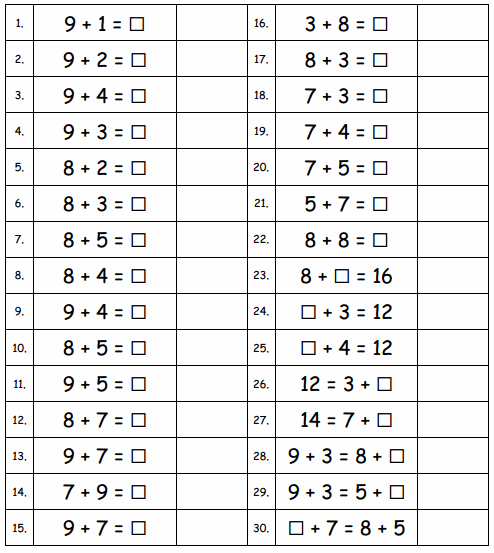
Answer:
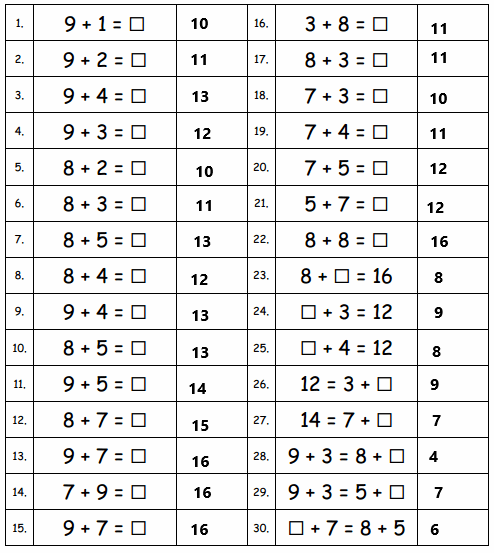
Question 1.
9 + 1 = ☐
Answer:
9 + 1 = 10
Explanation:
An addition sentence is a mathematical expression that shows two or more values added together. ADD nine with one then we got ten.
Question 2.
9 + 2 = ☐
Answer:
9 + 2= 11
Explanation:
An addition sentence is a mathematical expression that shows two or more values added together. ADD nine with two then we got eleven.
Question 3.
9 + 4 = ☐
Answer:
9 + 4 = 13
Explanation:
An addition sentence is a mathematical expression that shows two or more values added together. ADD nine with four then we got thirteen.
Question 4.
9 + 3 = ☐
Answer:
9 + 3 = 12
Explanation:
An addition sentence is a mathematical expression that shows two or more values added together. ADD nine with three then we got twelve.
Question 5.
8 + 2 = ☐
Answer:
8 + 2 = 10
Explanation:
An addition sentence is a mathematical expression that shows two or more values added together. ADD eight with two then we got ten.
Question 6.
8 + 3 = ☐
Answer:
8 + 3 = 11
Explanation:
An addition sentence is a mathematical expression that shows two or more values added together. ADD eight with three then we got eleven.
Question 7.
8 + 5 = ☐
Answer:
8 + 5 = 13
Explanation:
An addition sentence is a mathematical expression that shows two or more values added together. ADD eight with five then we got thirteen.
Question 8.
8 + 4 = ☐
Answer:
8 + 4 = 12
Explanation:
An addition sentence is a mathematical expression that shows two or more values added together. ADD eight with four then we got twelve.
Question 9.
9 + 4 = ☐
Answer:
9 + 4 = 13
Explanation:
An addition sentence is a mathematical expression that shows two or more values added together. ADD nine with four then we got thirteen.
Question 10.
8 + 5 = ☐
Answer:
8 + 5 = 13
Explanation:
An addition sentence is a mathematical expression that shows two or more values added together. ADD eight with five then we got thirteen.
Question 11.
9 + 5 = ☐
Answer:
9 + 5 = 14
Explanation:
An addition sentence is a mathematical expression that shows two or more values added together. ADD nine with five then we got fourteen.
Question 12.
8 + 7 = ☐
Answer:
8 + 7 = 15
Explanation:
An addition sentence is a mathematical expression that shows two or more values added together. ADD eight with seven then we got fifteen.
Question 13.
9 + 7 = ☐
Answer:
9 + 7 = 16
Explanation:
An addition sentence is a mathematical expression that shows two or more values added together. ADD nine with seven then we got sixteen.
Question 14.
7 + 9 = ☐
Answer:
7 + 9 = 16
Explanation:
An addition sentence is a mathematical expression that shows two or more values added together. ADD seven with nine then we got sixteen.
Question 15.
9 + 7 = ☐
Answer:
9 + 7 = 16
Explanation:
An addition sentence is a mathematical expression that shows two or more values added together. ADD nine with seven then we got sixteen.
Question 16.
3 + 8 = ☐
Answer:
3 + 8 =11
Explanation:
An addition sentence is a mathematical expression that shows two or more values added together. ADD three with eight then we got eleven.
Question 17.
8 + 3 = ☐
Answer:
8 + 3 = 11
Explanation:
An addition sentence is a mathematical expression that shows two or more values added together. ADD eight with three then we got eleven.
Question 18.
7 + 3 = ☐
Answer:
7 + 3 = 10
Explanation:
An addition sentence is a mathematical expression that shows two or more values added together. ADD seven with three then we got ten.
Question 19.
7 + 4 = ☐
Answer:
7 + 4 = 11
Explanation:
An addition sentence is a mathematical expression that shows two or more values added together. ADD seven with four then we got eleven.
Question 20.
7 + 5 = ☐
Answer:
7 + 5 = 12
Explanation:
An addition sentence is a mathematical expression that shows two or more values added together. ADD seven with five then we got twelve.
Question 21.
5 + 7 = ☐
Answer:
5 + 7 = 12
Explanation:
An addition sentence is a mathematical expression that shows two or more values added together. ADD five with seven then we got twelve.
Question 22.
8 + 8 = ☐
Answer:
8 + 8 = 16
Explanation:
An addition sentence is a mathematical expression that shows two or more values added together. ADD eight with eight then we got sixteen.
Question 23.
8 + ☐ = 16
Answer:
8 + 8 = 16
Explanation:
An addition sentence is a mathematical expression that shows two or more values added together. ADD eight with eight then we got sixteen.
Question 24.
☐ + 3 = 12
Answer:
9 + 3 = 12
Explanation:
An addition sentence is a mathematical expression that shows two or more values added together. ADD nine with three then we got twelve.
Question 25.
☐ + 4 = 12
Answer:
8 + 4 = 12
Explanation:
An addition sentence is a mathematical expression that shows two or more values added together. ADD eight with four then we got fourteen.
Question 26.
12 = 3 + ☐
Answer:
12= 3 + 9
Explanation:
An addition sentence is a mathematical expression that shows two or more values added together. ADD three with nine then we got twelve.
Question 27.
14 = 7 + ☐
Answer:
14 = 7 + 7
Explanation:
An addition sentence is a mathematical expression that shows two or more values added together. ADD seven with seven then we got fourteen.
Question 28.
9 + 3 = 8 + ☐
Answer:
9 + 3 = 8 + 4
Explanation:
An addition sentence is a mathematical expression that shows two or more values added together. ADD nine with three then we got twelve. ADD eight with four then we got twelve. Both are equal number sentences.
Question 29.
9 + 3 = 5 + ☐
Answer:
9 + 3 = 5 + 7
Explanation:
An addition sentence is a mathematical expression that shows two or more values added together. ADD nine with three then we got twelve. ADD five with seven then we got twelve. Both are equal number sentences.
Question 30.
☐ + 7 = 8 + 5
Answer:
6 + 7 = 8 + 5
Explanation:
An addition sentence is a mathematical expression that shows two or more values added together. ADD six with seven then we got thirteen. ADD eight with five then we got thirteen. Both are equal number sentences.
Eureka Math Grade 1 Module 2 Lesson 10 Problem Set Answer Key
Jeremy had 7 big rocks and 8 little rocks in his pocket.
How many rocks does Jeremy have?
Question 1.
Circle all student work that correctly matches the story.
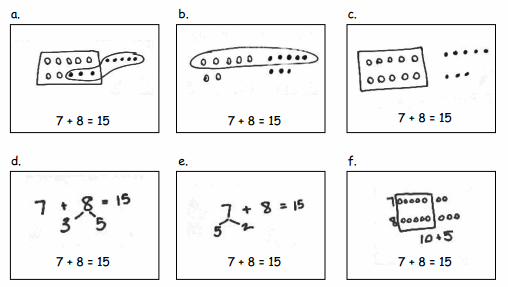
Answer:
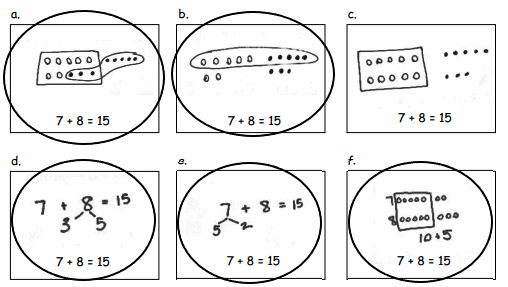
Explanation:
Jeremy had 7 big rocks and 8 little rocks in his pocket as we can observe in the above image.
a. The student drew the rocks in neat 5-groups. Student strategy was to make ten from seven by breaking eight into five and three. The student made a frame to show 10. Jeremy have fifteen rocks. Draw a circle for this student work which matches to the story.
b. The student drew the rocks in neat 5-groups. Student strategy was to make ten. Draw a circle for two five groups. ADD seven with eight then we got fifteen. Jeremy have fifteen rocks. Draw a circle for this student work which matches to the story.
c. The student drew the rocks in neat 5 – groups first. Later he drew the rocks in wrong count. Here we are getting eighteen rocks. The student work is not matched to the story.
d. A number bond is a simple addition of two numbers that add up to give the sum. The student used to make ten strategy and drew a number bond to break apart eight into three and five. ADD seven with three because they make ten. ADD ten with five then we got fifteen. Draw a circle for this student work which matches to the story.
e. A number bond is a simple addition of two numbers that add up to give the sum. The student used to make ten strategy and drew a number bond to break apart seven into five and two. ADD eight with two because they make ten. ADD ten with five then we got fifteen. Draw a circle for this student work which matches to the story.
f. The student drew the rocks in neat 5-groups. Student strategy was to make ten. ADD ten rocks with five rocks then we got fifteen rocks. Draw a circle for this student work which matches to the story.
Question 2
Fix the work that was incorrect by making a new drawing in the space below with the matching number sentence.
Solve on your own. Show your thinking by drawing or writing. Write a statement to answer the question.
Answer:
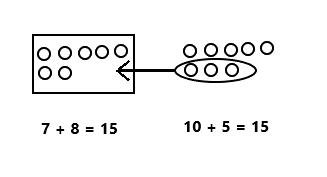
Explanation:
In the above image we can observe seven big rocks and eight little rocks. Draw the rocks into a 5-groups to make ten. Three little rocks are added to the seven big rocks which results ten rocks. ADD ten rocks with five rocks which results fifteen rocks.
Question 3.
There are 4 vanilla cupcakes and 8 chocolate cupcakes for the party. How many cupcakes were made for the party?
Answer:
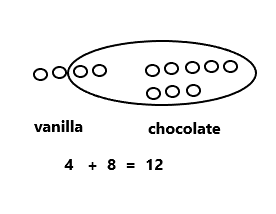
There are 12 cupcakes.
Explanation:
There are 4 vanilla cupcakes and 8 chocolate cupcakes for the party. ADD two vanilla cupcakes with eight chocolate cupcakes which results ten. ADD ten cupcakes with two vanilla cupcakes then we got twelve cupcakes. Twelve cupcakes are made for the party.
Question 4.
There are 5 girls and 7 boys on the playground. How many students are on the playground?
When you are done, share your solutions with a partner. How did your partner solve each problem? Be ready to share how your partner solved the problems.
Answer:
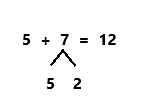
There are 12 students on the playground.
Explanation:
There are 5 girls and 7 boys on the playground. A number bond is a simple addition of two numbers that add up to give the sum. Break seven boys into two parts as five boys and two boys. ADD five boys with five girls which makes ten. ADD ten with two boys which results twelve. There are twelve students on the playground.
Eureka Math Grade 1 Module 2 Lesson 10 Exit Ticket Answer Key
John thinks the problem below should be solved using 5-group drawings, and Sue thinks it should be solved using a number bond. Solve both ways, and circle the strategy you think is the more efficient.
Kim scores 5 goals in her soccer game and 8 runs in her softball game. How many points does she score altogether?

Answer:

Kim score 13 points altogether.
Explanation:
Kim scores 5 goals in her soccer game and 8 runs in her softball game as we can observe in the above image.
a. John used a 5 group drawing to solve the problem. ADD eight runs in softball game with two goals in soccer game to make ten points. ADD ten points with three goals in soccer game then we got thirteen points. Kim score 13 points altogether.
b. sue used a number bond to solve the problem. A number bond is a simple addition of two numbers that add up to give the sum. Break five goals in soccer game into two parts as two and three. ADD eight runs in softball game with two goals in soccer game to make ten points. ADD ten points with three goals in soccer game then we got thirteen points. Kim score 13 points altogether. Draw a circle for Sue’s work because number bond is more efficient strategy to solve the problem.
Eureka Math Grade 1 Module 2 Lesson 10 Homework Answer Key
Look at the student work. Correct the work. If the answer is incorrect, show a correct solution in the space below the student work.
Question 1.
Todd has 9 red cars and 7 blue cars. How many cars does he have altogether?

Answer:

Todd have 16 cars altogether.
Explanation:
Todd has 9 red cars and 7 blue cars as we can observe in the above image.
1. Mary used a 5 group drawing work to make ten cars from seven blue cars by breaking seven blue cars into one and six. He made a frame to show ten. He added nine red cars with one blue car to make ten cars. ADD ten cars with six blue cars which results sixteen cars. Todd have sixteen cars.
2. Joe used a number bond to make ten. A number bond is a simple addition of two numbers that add up to give the sum. In the above number sentence seven blue cars are divided into two parts as one and six. ADD nine red cars with one blue car to make ten cars. ADD ten cars with six blue cars then we got sixteen cars. Todd have sixteen cars.
3. Len used a neat 5 group drawing. He added nine red cars with one blue car to make ten cars. ADD ten cars with six blue cars which results sixteen cars. Todd have sixteen cars.
Question 2.
Jill has 8 beta fish and 5 goldfish. How many fish does she have in total?

Answer:

Jill have 13 fish.
Explanation:
Jill has 8 beta fish and 5 goldfish as we can observe in the above image.
1. Frank used a 5 group drawing to make ten. Break five goldfish into two parts as two and three. ADD eight beta fish with two gold fish to make ten fish. ADD ten fish with three goldfish then we got thirteen fish.
2. Lori used a number bond to make ten. A number bond is a simple addition of two numbers that add up to give the sum. Break five gold fish into two parts as two and three. ADD eight beta fish with two gold fish to make ten fish. ADD ten fish with three goldfish then we got thirteen fish.
3. Mike used a neat 5 group drawing. He added eight beta fish with two goldfish to make ten fish. ADD ten fish with three goldfish then we got thirteen fish.
Question 3.
Dad baked 7 chocolate and 6 vanilla cupcakes. How many cupcakes did he bake in all?

Answer:

Dad baked 13 cupcakes.
Explanation:
Dad baked 7 chocolate and 6 vanilla cupcakes as we can observe in the above image.
a. Mary used a 5 group drawing to make ten. Break six vanilla cupcake into two parts as three and three. ADD seven chocolate cupcakes with three vanilla cupcakes to make ten cupcakes. ADD ten cupcakes with three vanilla cupcakes then we got thirteen cupcakes.
b. Joe used a neat 5 group drawing. He added five chocolate cupcakes with five vanilla cupcakes to make ten cupcakes. ADD ten cupcakes with one vanilla cupcake and two chocolate cupcakes then we got thirteen cupcakes.
c. Lori used a number bond to make ten. A number bond is a simple addition of two numbers that add up to give the sum. Break six vanilla cupcake into two parts as three and three. ADD seven chocolate cupcakes with three vanilla cupcakes to make ten cupcakes. ADD ten cupcakes with three vanilla cupcakes then we got thirteen cupcakes.
Question 4.
Mom caught 9 fireflies, and Sue caught 8 fireflies. How many fireflies did they catch altogether?

Answer:

They caught 17 fireflies altogether.
Explanation:
Mom caught 9 fireflies, and Sue caught 8 fireflies as we can observe in the above image.
a. Mike used a 5 group drawing to make ten. Break eight fireflies of Sue into two parts as one and seven. ADD nine fireflies of Mom with one fireflies of Sue to make ten fireflies. ADD ten fireflies with seven fireflies of sue then we got seventeen fireflies.
b. Len used a neat 5 group drawing. ADD nine fireflies of Mom with one fireflies of Sue to make ten fireflies. ADD ten fireflies with seven fireflies of sue then we got seventeen fireflies.
c. Frank used a number bond to make ten. A number bond is a simple addition of two numbers that add up to give the sum. Break eight fireflies of Sue into two parts as one and seven. ADD nine fireflies of Mom with one fireflies of Sue to make ten fireflies. ADD ten fireflies with seven fireflies of sue then we got seventeen fireflies.